定语从句的译法概要
定语从句翻译方式
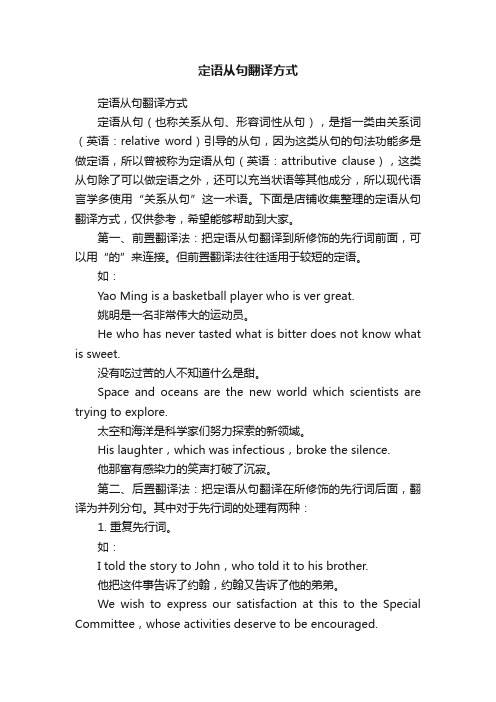
定语从句翻译方式定语从句翻译方式定语从句(也称关系从句、形容词性从句),是指一类由关系词(英语:relative word)引导的从句,因为这类从句的句法功能多是做定语,所以曾被称为定语从句(英语:attributive clause),这类从句除了可以做定语之外,还可以充当状语等其他成分,所以现代语言学多使用“关系从句”这一术语。
下面是店铺收集整理的定语从句翻译方式,仅供参考,希望能够帮助到大家。
第一、前置翻译法:把定语从句翻译到所修饰的先行词前面,可以用“的”来连接。
但前置翻译法往往适用于较短的定语。
如:Yao Ming is a basketball player who is ver great.姚明是一名非常伟大的运动员。
He who has never tasted what is bitter does not know what is sweet.没有吃过苦的人不知道什么是甜。
Space and oceans are the new world which scientists are trying to explore.太空和海洋是科学家们努力探索的新领域。
His laughter,which was infectious,broke the silence.他那富有感染力的笑声打破了沉寂。
第二、后置翻译法:把定语从句翻译在所修饰的先行词后面,翻译为并列分句。
其中对于先行词的处理有两种:1. 重复先行词。
如:I told the story to John,who told it to his brother.他把这件事告诉了约翰,约翰又告诉了他的弟弟。
We wish to express our satisfaction at this to the Special Committee,whose activities deserve to be encouraged.在我们对特别委员会表示满意,特别委员会的工作应该受到鼓励。
定语从句怎么翻译

定语从句怎么翻译定语从句是指在句子中修饰一个名词或代词的从句。
翻译定语从句时需要注意保持原句的结构和语法正确性,并将定语从句与先行词之间的关系清晰地表达出来。
以下是关于定语从句的翻译方法与技巧。
1. 基本型定语从句的基本型翻译方法是将从句直接放在先行词之后,并根据句子的语序和语法结构进行对应调整。
例句1:I like the book that you recommended.翻译:我喜欢你推荐的那本书。
2. 删除关系词在某些情况下,定语从句中的关系词可以被省略,但在翻译时需要补全,以确保句子的完整性和准确性。
例句2:He's the boy I saw yesterday.翻译:他是我昨天看到的那个男孩。
3. 变换关系词定语从句中的关系词可以根据语境和需要进行变换,使翻译更符合目标语言的表达习惯。
例句3:This is the city where I was born.翻译:这是我出生的那个城市。
4. 递变关系词的位置定语从句的关系词在翻译时可以根据需要进行位置的变换,以便更好地表达出从句与先行词之间的关系。
例句4:She is the woman whose car broke down.翻译:她是那辆车坏了的那个女士。
5. 使用介词短语有时候,为了更准确地表达从句与先行词之间的关系,可以使用介词短语来翻译定语从句。
例句5:I have a friend from Japan whose father is a famous musician.翻译:我有一个来自日本的朋友,他的父亲是一位著名的音乐家。
6. 倒装句有时候,定语从句的翻译可以采用倒装句的形式,以改变语序和强调从句的内容。
例句6:There is a book on the table which I need.翻译:桌子上有一本书,我需要它。
综上所述,翻译定语从句需要根据原句的语法结构和语义关系,灵活运用各种翻译方法和技巧,以确保翻译的准确性和流畅性。
定语从句英译汉的方法

定语从句英译汉的方法
定语从句英译汉的方法
定语从句是英语语法中的一个重要部分,它用于修饰和描述名词或代词。
定语从句的形式是通过引导词(如that、which、who、whom、whose等)与主句相连,形成一个子句来修饰名词或代词。
在汉语中,它通常使用的是“的”字结构来表达。
在翻译定语从句的时候,需要注意以下几个方面:
1. 找到引导词
首先,需要找到定语从句中的引导词,它是连接主句和从句的桥梁。
在翻译过程中,需要根据引导词的不同来选择不同的翻译方式。
2. 确定从句成分
其次,需要确定定语从句中的主语、谓语、宾语等成分,以便正确翻译。
在汉语中,需要根据上下文和语境来确定从句成分的位置和顺序。
3. 注意语序和连词
在翻译定语从句时,需要注意语序和连词的使用。
汉语和英语的语序存在差异,需要根据语言习惯和表达习惯来决定翻译方式。
同时,连词的使用也需要符合语法和表达的要求,不能随意更改。
4. 确定修饰内容
定语从句的作用是修饰和描述名词或代词,在翻译时需要准确表达修饰内容,保证句子的意思清晰明了。
总之,翻译定语从句需要根据具体情况进行灵活处理,遵循语言规范和表达习惯,保证翻译的准确性和流畅性。
定语从句的翻译方法

定语从句的翻译方法
定语从句是用来修饰名词或代词的从句,常常用来给出额外的信息来
进一步说明该名词或代词。
翻译定语从句时,一般可以采用以下方法:
1.将定语从句翻译为一个完整的句子,放在被修饰的名词或代词后面。
例如:
- The girl who is sitting next to me is my best friend.
-坐在我旁边的那个女孩是我最好的朋友。
2.将定语从句翻译为一个介词短语,并用该介词短语修饰被修饰的名
词或代词。
例如:
- The book that I am reading is very interesting.
-我正在看的那本书非常有趣。
3.将定语从句翻译为一个形容词短语,并用该形容词短语修饰被修饰
的名词或代词。
例如:
- The man who is wearing a hat is my father.
-戴着帽子的那个男人是我爸爸。
注意:翻译定语从句时要注意上下文的语境,并使得翻译后的句子通顺、流畅。
定语从句的翻译
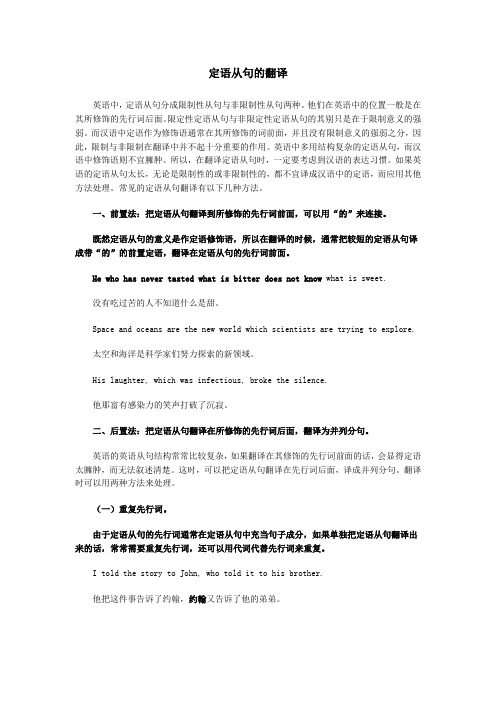
定语从句的翻译英语中,定语从句分成限制性从句与非限制性从句两种。
他们在英语中的位置一般是在其所修饰的先行词后面。
限定性定语从句与非限定性定语从句的其别只是在于限制意义的强弱。
而汉语中定语作为修饰语通常在其所修饰的词前面,并且没有限制意义的强弱之分,因此,限制与非限制在翻译中并不起十分重要的作用。
英语中多用结构复杂的定语从句,而汉语中修饰语则不宜臃肿。
所以,在翻译定语从句时,一定要考虑到汉语的表达习惯。
如果英语的定语从句太长,无论是限制性的或非限制性的,都不宜译成汉语中的定语,而应用其他方法处理。
常见的定语从句翻译有以下几种方法。
一、前置法:把定语从句翻译到所修饰的先行词前面,可以用“的”来连接。
既然定语从句的意义是作定语修饰语,所以在翻译的时候,通常把较短的定语从句译成带“的”的前置定语,翻译在定语从句的先行词前面。
He who has never tasted what is bitter does not know what is sweet.没有吃过苦的人不知道什么是甜。
Space and oceans are the new world which scientists are trying to explore.太空和海洋是科学家们努力探索的新领域。
His laughter, which was infectious, broke the silence.他那富有感染力的笑声打破了沉寂。
二、后置法:把定语从句翻译在所修饰的先行词后面,翻译为并列分句。
英语的英语从句结构常常比较复杂,如果翻译在其修饰的先行词前面的话,会显得定语太臃肿,而无法叙述清楚。
这时,可以把定语从句翻译在先行词后面,译成并列分句。
翻译时可以用两种方法来处理。
(一)重复先行词。
由于定语从句的先行词通常在定语从句中充当句子成分,如果单独把定语从句翻译出来的话,常常需要重复先行词,还可以用代词代替先行词来重复。
I told the story to John, who told it to his brother.他把这件事告诉了约翰,约翰又告诉了他的弟弟。
如何翻译定语从句

如何翻译定语从句如何翻译定语从句有时,一个从句在句法功能上来看是定语从句,但在语意上却含有时间、原因、目的、结果或是让步等逻辑关系,这就让定语从句的翻译成为一大难点。
今天店铺就为大家总结一下定语从句的常见译法,希望能帮助大家攻克这一难点。
一、译成前置定语这一方法主要适用于一些限定性定语从句或是较短的定语从句。
限制性定语从句指的是与先行词关系较为紧密的'定语从句,一般没有标点符号将其与先行词分开。
例如:Terrorism is a pressing problem that we must deal with.这句话中的定语从句较短而且跟先行词“problem”关系紧密,所以可以按照汉语中的习惯将定语前置,译作“恐怖主义是我们必须解决的一个迫切问题”。
二、译成并列分句对于一些结构复杂或意义较独立的限制性定语从句,以及大部分非限制性定语从句(与先行词关系不太紧密的定语从句,与先行词间常有标点隔开),可以将其单独译成一个句子,后置做并列从句。
为了使其与主句逻辑关系清晰,有时需要根据与主句的关系加一些连词。
例如:I was endeavoring to put off one sort of life for another sort of life, which was not better than the life I had known.这句话中有一个非限制性定语从句,其与前面的主句在逻辑上是转折的关系,所以在翻译时可以将其单译成一个句子,然后根据逻辑关系,在两句中间加上表转折的关联词。
所以这句话可以译为“我一直在竭力摆脱一种而改换另一种生活,但是我所改换的生活并不见得比原先的生活好。
”三、译成主句成分适用于这一译法的句子通常有两种,一种是含有定语从句的“there be”结构,另一种是主句较短的句子。
前者在翻译时不需理会“there be”结构,只要将先行词带入定语从句,再直接翻译定语从句的意思就好;而后者则需要将主句译成译文的主语。
考研英语翻译技巧点拨:定语从句翻译法
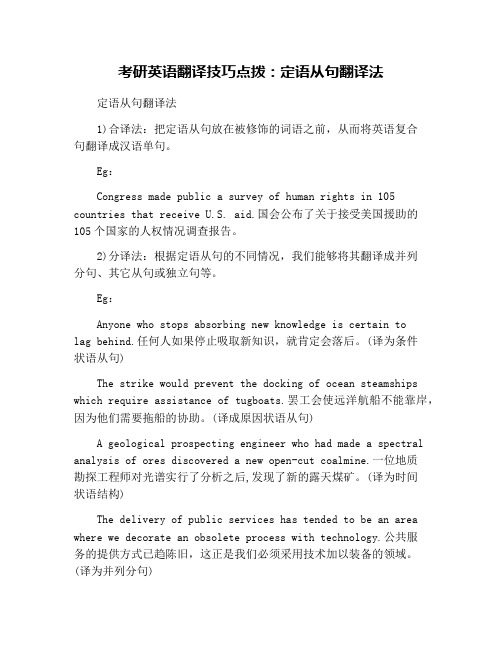
考研英语翻译技巧点拨:定语从句翻译法定语从句翻译法1)合译法:把定语从句放在被修饰的词语之前,从而将英语复合句翻译成汉语单句。
Eg:Congress made public a survey of human rights in 105 countries that receive U.S. aid.国会公布了关于接受美国援助的105个国家的人权情况调查报告。
2)分译法:根据定语从句的不同情况,我们能够将其翻译成并列分句、其它从句或独立句等。
Eg:Anyone who stops absorbing new knowledge is certain tolag behind.任何人如果停止吸取新知识,就肯定会落后。
(译为条件状语从句)The strike would prevent the docking of ocean steamships which require assistance of tugboats.罢工会使远洋航船不能靠岸,因为他们需要拖船的协助。
(译成原因状语从句)A geological prospecting engineer who had made a spectral analysis of ores discovered a new open-cut coalmine.一位地质勘探工程师对光谱实行了分析之后,发现了新的露天煤矿。
(译为时间状语结构)The delivery of public services has tended to be an area where we decorate an obsolete process with technology.公共服务的提供方式已趋陈旧,这正是我们必须采用技术加以装备的领域。
(译为并列分句)We now live in a very new economy, a service economy, where relationships are becoming more important than physical products.现在我们正生活于一种全新的经济,即服务性经济中,各种关系越来越比物质产品更为重要。
第五章 第四节 定语从句的译法
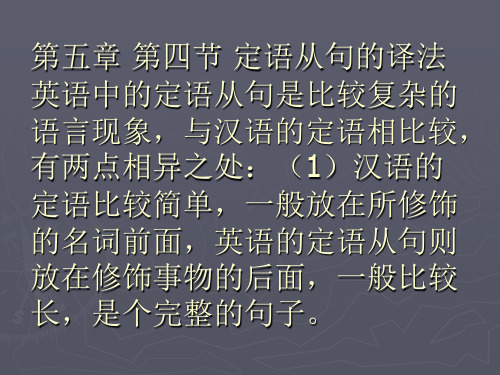
6.表时间 A driver mustn’t talk with others or be absent-minded who is driving the bus.
司机开车时,不许和人谈话,也不能走 神。
5. The grammar school legally could only teach the classical subjects for which they had been founded.
按规定文法学校只能讲授古典学科,这 些学科的办学宗旨本来就是如此。
三、压缩溶合法 There be 句型中和谓语动词是be 的句子中所含的定语从句,一般 与主语的关系比较密切,翻译时 通常与主句溶合在一起译,往往 可以把定语从句当成主体,译成 谓语部分,把主句中的主语充当 主语,从而把复合句融合成一个 简单句。
4. Kissinger and his small group of aids toured the Forbidden City, where the Chinese emperors once lived in lofty splendor.
基辛格和他的一小组随从参观了故宫, 从前的中国皇帝曾在这故宫里过着奢华 显赫的生活。
他曾送给我一本书,(这本书)我直保 存至今。
2. We wish to express our satisfaction at this to the Special Committee, whose activities deserve to be encouraged.
在此我们对特别委员会表示满意,特别 委员会的工作应该受到鼓励。
3. Relations between China and Denmark which dates back in January 1950 is friendly.
定语从句英译汉的方法

定语从句英译汉的方法定语从句是英语语法中的重要部分,可以用来描述和限定名词或代词。
在翻译时,正确理解和使用定语从句是非常重要的。
以下是一些方法和技巧,可以帮助你正确翻译定语从句。
1. 理解定语从句的结构定语从句由引导词和从句组成。
引导词包括关系代词(who, whom, whose, which, that)和关系副词(when, where, why)。
从句是一个完整的句子,包含主语、谓语和宾语等要素。
在翻译时,需要理解定语从句的结构,并将其翻译成符合汉语语法规则的句子。
2. 熟悉定语从句的用法定语从句可以用来描述或限定名词或代词。
在翻译时,需要根据上下文理解定语从句的用法,并将其翻译成对应的汉语表达方式。
例如:- The book that I borrowed from the library is very interesting.(我从图书馆借来的那本书非常有趣。
)- The man who is standing over there is my boss.(站在那边的那个人是我的老板。
)3. 注意定语从句的位置定语从句可以出现在句首、句中或句末。
在翻译时,需要根据定语从句的位置进行适当的调整。
例如:- The book, which I borrowed from the library, is very interesting.(我从图书馆借来的那本书非常有趣。
)- The man is my boss, who is standing over there.(那个站在那边的人是我的老板。
)- The book is very interesting that I borrowed from the library.(我从图书馆借来的那本书非常有趣。
)4. 注意关系代词的用法关系代词在定语从句中起到连接作用,可以替代先行词。
在翻译时,需要根据关系代词的用法进行适当的翻译。
例如:- The girl who is wearing a red dress is my sister.(穿红色裙子的那个女孩是我的妹妹。
定语从句四大翻译方法
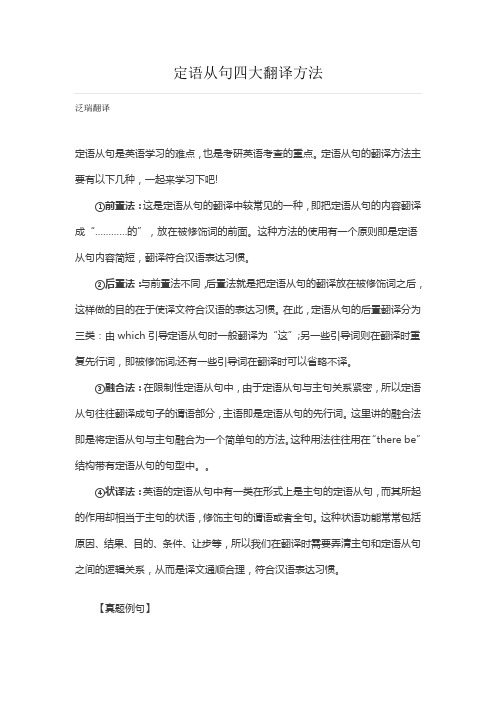
定语从句四大翻译方法泛瑞翻译定语从句是英语学习的难点,也是考研英语考查的重点。
定语从句的翻译方法主要有以下几种,一起来学习下吧!①前置法:这是定语从句的翻译中较常见的一种,即把定语从句的内容翻译成“…………的”,放在被修饰词的前面。
这种方法的使用有一个原则即是定语从句内容简短,翻译符合汉语表达习惯。
②后置法:与前置法不同,后置法就是把定语从句的翻译放在被修饰词之后,这样做的目的在于使译文符合汉语的表达习惯。
在此,定语从句的后置翻译分为三类:由which引导定语从句时一般翻译为“这”;另一些引导词则在翻译时重复先行词,即被修饰词;还有一些引导词在翻译时可以省略不译。
③融合法:在限制性定语从句中,由于定语从句与主句关系紧密,所以定语从句往往翻译成句子的谓语部分,主语即是定语从句的先行词。
这里讲的融合法即是将定语从句与主句融合为一个简单句的方法。
这种用法往往用在“there be”结构带有定语从句的句型中。
④状译法:英语的定语从句中有一类在形式上是主句的定语从句,而其所起的作用却相当于主句的状语,修饰主句的谓语或者全句。
这种状语功能常常包括原因、结果、目的、条件、让步等,所以我们在翻译时需要弄清主句和定语从句之间的逻辑关系,从而是译文通顺合理,符合汉语表达习惯。
【真题例句】Behaviorists suggest that the child who is raised in an environment where there are many stimuli which develop his or her capacity for appropriate responses will experience greater intellectual development.【解析】句子可拆分为:Behaviorists suggest //that the child //who is raised in an environment //where there are many stimuli// which develop his or her capacity for appropriate responses// will experience greater intellectual development.is raised是从属连词who从句的动词;are是where从句的动词;develop 是which从句的动词;由于跟在从属连词后的动词不可能是主句的谓语动词,所以前面提到的三个动词全都不是主句的谓语动词。
定语从句的翻译方法
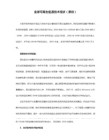
另外,有些定语从句英译汉时要需要将主句压缩成主语,而将定语从句译成谓语,融合为一个句子。
另外,在英语中常常会把需要强调的内容放于句首,而汉语中却习惯把附加性说明的定语部分翻译成后置型的并列分句,以求在形式上突出主句的内容。
例1: She suddenly thought of her husband, who had left her and their children behind and had never been heard of. 译文:他丈夫早就抛弃了妻儿一直杳无音信,现在她突然想起了他。
2.译成谓语 当定语从句是存在句,尤其是在“there be结构”和它的变体结构、以及在“it be +主语+定语从句”的结构中,定语从句的谓语在意义上也是整个主句的谓语,因此在英译汉时可将其译为主谓结构的简单句。
例1:There were men in that crowd who had stood there every day for a month.译文:在那群人中,有的人每天都站在那里,站了一个月。
例1:He took out a bottle of wine out of his pocket, which he began to drink slowly.译文:他从衣兜里掏出一瓶酒慢慢地喝起来。
例2: We will send the boy to Britain, where he can receive better education.译文:我们将要把这个孩子送到英国去接受更好的教育。
《定语从句》的翻译方法
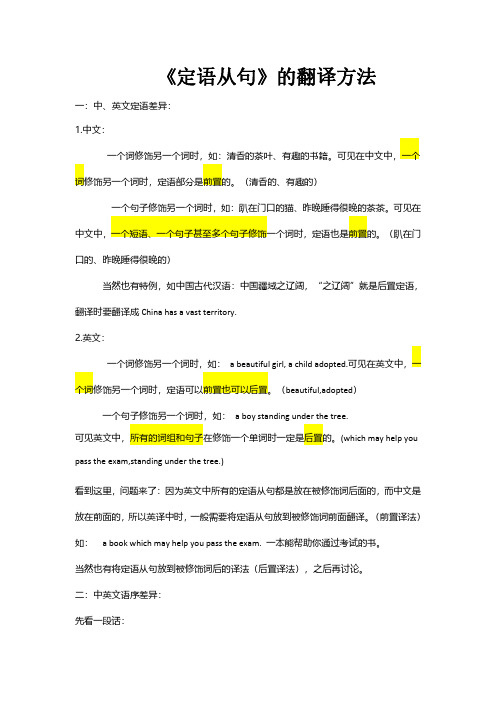
《定语从句》的翻译方法一:中、英文定语差异:1.中文:一个词修饰另一个词时,如:清香的茶叶、有趣的书籍。
可见在中文中,一个词修饰另一个词时,定语部分是前置的。
(清香的、有趣的)一个句子修饰另一个词时,如:趴在门口的猫、昨晚睡得很晚的茶茶。
可见在中文中,一个短语、一个句子甚至多个句子修饰一个词时,定语也是前置的。
(趴在门口的、昨晚睡得很晚的)当然也有特例,如中国古代汉语:中国疆域之辽阔,“之辽阔”就是后置定语,翻译时要翻译成China has a vast territory.2.英文:一个词修饰另一个词时,如:a beautiful girl,a child adopted.可见在英文中,一个词修饰另一个词时,定语可以前置也可以后置。
(beautiful,adopted)一个句子修饰另一个词时,如:a boy standing under the tree.可见英文中,所有的词组和句子在修饰一个单词时一定是后置的。
(which may help you pass the exam,standing under the tree.)看到这里,问题来了:因为英文中所有的定语从句都是放在被修饰词后面的,而中文是放在前面的,所以英译中时,一般需要将定语从句放到被修饰词前面翻译。
(前置译法)如:a book which may help you pass the exam.一本能帮助你通过考试的书。
当然也有将定语从句放到被修饰词后的译法(后置译法),之后再讨论。
二:中英文语序差异:先看一段话:中国作为一个发展中的大国高度重视中美两国之间的友谊。
翻译1:China is a major developing country and attaches great importance to the bilateral relations between China and the U.S.翻译2:As a major developing country,China attaches great importance to the bilateral relations between China and the U.S.这两种翻译看上去都是对的,因为两种都不影响理解。
定语从句的译法
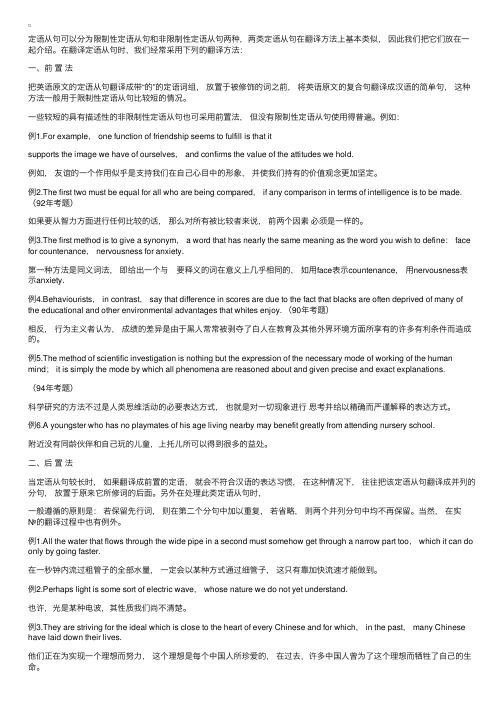
定语从句可以分为限制性定语从句和⾮限制性定语从句两种,两类定语从句在翻译⽅法上基本类似,因此我们把它们放在⼀起介绍。
在翻译定语从句时,我们经常采⽤下列的翻译⽅法:⼀、前置法把英语原⽂的定语从句翻译成带“的”的定语词组,放置于被修饰的词之前,将英语原⽂的复合句翻译成汉语的简单句,这种⽅法⼀般⽤于限制性定语从句⽐较短的情况。
⼀些较短的具有描述性的⾮限制性定语从句也可采⽤前置法,但没有限制性定语从句使⽤得普遍。
例如:例1.For example, one function of friendship seems to fulfill is that itsupports the image we have of ourselves, and confirms the value of the attitudes we hold.例如,友谊的⼀个作⽤似乎是⽀持我们在⾃⼰⼼⽬中的形象,并使我们持有的价值观念更加坚定。
例2.The first two must be equal for all who are being compared, if any comparison in terms of intelligence is to be made.(92年考题)如果要从智⼒⽅⾯进⾏任何⽐较的话,那么对所有被⽐较者来说,前两个因素必须是⼀样的。
例3.The first method is to give a synonym, a word that has nearly the same meaning as the word you wish to define: face for countenance, nervousness for anxiety.第⼀种⽅法是同义词法,即给出⼀个与 要释义的词在意义上⼏乎相同的,如⽤face表⽰countenance,⽤nervousness表⽰anxiety.例4.Behaviourists, in contrast, say that difference in scores are due to the fact that blacks are often deprived of many of the educational and other environmental advantages that whites enjoy. (90年考题)相反,⾏为主义者认为,成绩的差异是由于⿊⼈常常被剥夺了⽩⼈在教育及其他外界环境⽅⾯所享有的许多有利条件⽽造成的。
定语从句的英语翻译方法
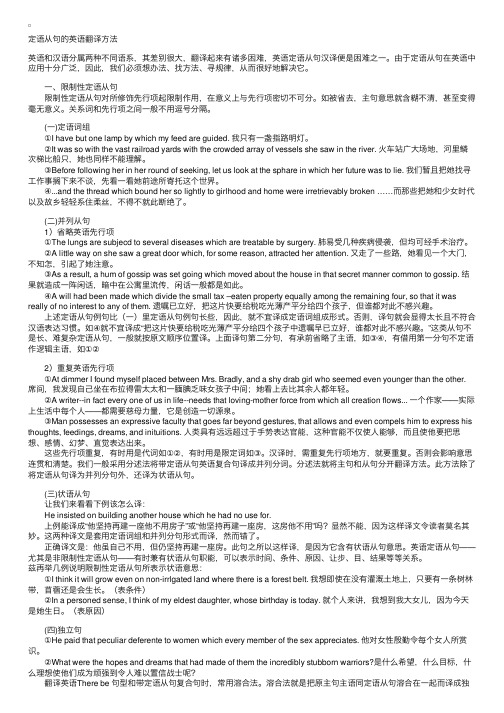
定语从句的英语翻译⽅法英语和汉语分属两种不同语系,其差别很⼤,翻译起来有诸多困难,英语定语从句汉译便是困难之⼀。
由于定语从句在英语中应⽤⼗分⼴泛,因此,我们必须想办法、找⽅法、寻规律,从⽽很好地解决它。
⼀、限制性定语从句 限制性定语从句对所修饰先⾏项起限制作⽤,在意义上与先⾏项密切不可分。
如被省去,主句意思就含糊不清,甚⾄变得毫⽆意义。
关系词和先⾏项之间⼀般不⽤逗号分隔。
(⼀)定语词组 ①I have but one lamp by which my feed are guided. 我只有⼀盏指路明灯。
②It was so with the vast railroad yards with the crowded array of vessels she saw in the river. ⽕车站⼴⼤场地,河⾥鳞次梯⽐船只,她也同样不能理解。
③Before following her in her round of seeking, let us look at the sphare in which her future was to lie. 我们暂且把她找寻⼯作事搁下来不谈,先看⼀看她前途所寄托这个世界。
④...and the thread which bound her so lightly to girlhood and home were irretrievably broken ……⽽那些把她和少⼥时代以及故乡轻轻系住柔丝,不得不就此断绝了。
(⼆)并列从句 1)省略英语先⾏项 ①The lungs are subjecd to several diseases which are treatable by surgery. 肺易受⼏种疾病侵袭,但均可经⼿术治疗。
②A little way on she saw a great door which, for some reason, attracted her attention. ⼜⾛了⼀些路,她看见⼀个⼤门,不知怎,引起了她注意。
定语从句英文翻译方法

定语从句英文翻译方法定语从句英文翻译方法定语从句,一个简单句跟在一名词或代词后(先行词)进行修饰限定,就叫做定语从句。
下面是店铺为大家整理的定语从句英文翻译方法,欢迎大家借鉴与参考,希望对大家有所帮助。
一、前置译法如果一个定语从句在句中的作用是修饰和限定名词,那么通常就采取译为前置定语的方法。
但注意译成前置定语后既不能影响原文所表达的意思,还要使整个句子的表达言简意赅、连贯通顺、语气较强。
例句:Water, which is a clear liquid, has many uses.译文:水是一种清澈的液体,有许多用途。
在前置译法的过程中如果定语从句中的谓语不含有具体意义,可省译从句中的谓语。
这种译法很简便,也很有效。
有时候,出于汉语行文的需要和逻辑关系方面的考虑,可将定语从句提在主语之前翻译,用来说明情况,但不作为被修饰名词的定语。
例句:There are also great advantages that come from the variety of culture brought by settlers from other lands.译文:移民从个地方带来了多种文化,产生了极大的好处。
二、后置译法我们都知道,英语中很多定语从句都是为了连接两个具有共同名词的句子而存在的,因此在翻译时最好分为两个分句。
而对于起限定作用的定语从句,如果结构较为复杂,句子太长,无法译成前置的定语,最后就译成一个后置的并列分句,这样更合乎汉语的习惯。
例句:Our war against terror is a contest of will in which perseverance is power.译文:我们的反恐战争是一场意志力的较量。
在这场较量中,不屈不挠的精神就是力量。
结构较复杂的定语从句常译成后置的并列分句,在多数情况下要重译先行词,或即便句子不长,出于某种原因需要强调先行词,也要重译先行词。
[全]英语语法-定语从句的翻译方法详解
![[全]英语语法-定语从句的翻译方法详解](https://img.taocdn.com/s3/m/58d09abbfe4733687f21aac1.png)
[全]英语语法-定语从句的翻译方法详解定语从句的翻译中文的定语从句:1、前置定语(1)一个词修饰另一个词,一般是前置:例如:一个漂亮的女孩清香的茶叶著名的诗人(2)一个短语或是一个句子或是多个句子修饰一个词,一般是前置:例如:坐在门口的孩子拿着手机的小姑娘昨天晚上趴在房上的小白猫2、后置定语古代汉语中存在定语后置的情况:例如:中国疆域之辽阔,人口之众多,资源之丰富。
“之”引起的定语后置的情况。
China has a vast territory, a large population and plentiful resources.territory: n. 领土;地盘;范围英文的定语从句:一个单词修饰另一个单词,1、一般是前置:e.g: a pretty girla famous poet2、后置:(1)过去分词修饰名词,可以是后置定语,但不等同于所有的过去分词在修饰名词时都后置e.g.: a child adopted(2)以a-开头的形容词(也称为表语形容词)修饰名词时,一定要后置,基本上所有a-开头的形容词做定语时都要后置e.g.: a physician alive所有词组和句子修饰一个单词时都是后置,没有前置——定语从句。
英文中的定语翻译成中文时,一定是前置e.g: a boy standing under the treetwo women waiting for youa kind of knowledge which can enlighten the whole worlda book which may help you pass this exam英译汉的步骤:第一步:断句第二步:翻译第三部:重读e.g: On the whole, /such a conclusion can be drawn /with a certain degree of confidence, /but only if the child can be assumed to have had the same attitude /towards the test /as the others /with whom he is being compared, /and only if he was not punished /by lack of relevant information /which they possessed.第一步断句第二步翻译:字对字翻译译:总体上来说1,得出这样一种结论2需要3一定程度的把握,只要假设这个孩子对于测试的态度,和与之相比较的其他孩子的4态度相同5,也只要他没有因为缺少别的孩子所拥有6的相关信息而受到惩罚7。
谈英语定语从句的翻译方法
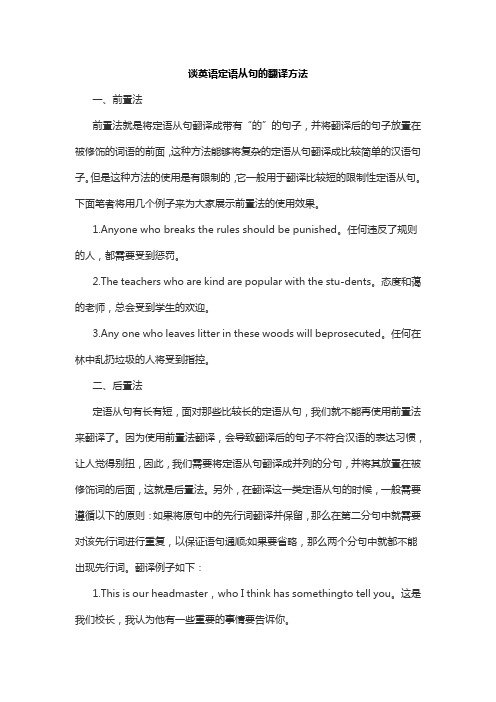
谈英语定语从句的翻译方法一、前置法前置法就是将定语从句翻译成带有“的”的句子,并将翻译后的句子放置在被修饰的词语的前面,这种方法能够将复杂的定语从句翻译成比较简单的汉语句子。
但是这种方法的使用是有限制的,它一般用于翻译比较短的限制性定语从句。
下面笔者将用几个例子来为大家展示前置法的使用效果。
1.Anyone who breaks the rules should be punished。
任何违反了规则的人,都需要受到惩罚。
2.The teachers who are kind are popular with the stu-dents。
态度和蔼的老师,总会受到学生的欢迎。
3.Any one who leaves litter in these woods will beprosecuted。
任何在林中乱扔垃圾的人将受到指控。
二、后置法定语从句有长有短,面对那些比较长的定语从句,我们就不能再使用前置法来翻译了。
因为使用前置法翻译,会导致翻译后的句子不符合汉语的表达习惯,让人觉得别扭,因此,我们需要将定语从句翻译成并列的分句,并将其放置在被修饰词的后面,这就是后置法。
另外,在翻译这一类定语从句的时候,一般需要遵循以下的原则:如果将原句中的先行词翻译并保留,那么在第二分句中就需要对该先行词进行重复,以保证语句通顺;如果要省略,那么两个分句中就都不能出现先行词。
翻译例子如下:1.This is our headmaster,who I think has somethingto tell you。
这是我们校长,我认为他有一些重要的事情要告诉你。
2.They have been spurred in part by DNA evidencemade available in 1998.which almost certainly provedThomas Jefferson had fathered at least one child with hisslave Sally Hemings。
定语从句句子翻译方法

定语从句句子翻译方法定语从句句子翻译方法定语从句在句中做定语,修饰一个名词或代词,被修饰的名词,词组或代词即。
定语从句通常出现在先行词之后,由关系词引出。
以下是小编整理的定语从句句子翻译方法,欢迎阅读。
1,前置法当从句结构和意义比较简单,不会对主句部分造成理解上的困难,此时可以前置法,把它翻译成“…的”的定语词组,并放在被修饰词的前面。
将英语的复合句翻译成汉语的简单句。
Since our chief business with them is to enable them to share in a common life we can not help considering whether or not we are forming the powers which will secure this ability.在这个句子中,关系代词指代前面的powers,这个简单的定语从句构成比较简单,只有几个单词构成,因此万学海文建议考生们在翻译的时候就要把它放在所修饰的先行词之前。
参考译文:由于我们对年轻人所做的首要工作在于使他们能够在生活中相处地融洽,因此我们不禁要考虑自己是否在形成让他们获得这种能力的力量。
2,后置法当从句结构较为复杂,意义较为繁琐,意思表达不清时,选择用后置法,此时把定语从句单独翻译成一个句子,放在原来它所修饰的词的后面,关系代词可以翻译为先行词,或者与先行词相对应的代词。
In Europe, as elsewhere, multi-media groups have been increasingly successful; groups which bring together television, radio newspapers, magazines and publishing houses that work in relation to one another.本句中含有两个定语从句,一个用which引导,一个用that引导,对于which引导的定语从句,无论从结构和意义上来说,都比较复杂,所以在翻译的时候,万学海文提醒考生们可以把它和先行词拆开,单独翻译成一个句子。
定语从句的译法
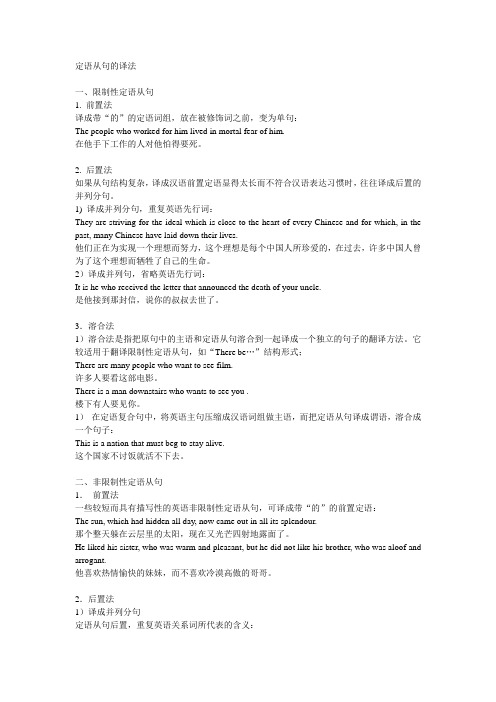
定语从句的译法一、限制性定语从句1. 前置法译成带“的”的定语词组,放在被修饰词之前,变为单句:The people who worked for him lived in mortal fear of him.在他手下工作的人对他怕得要死。
2. 后置法如果从句结构复杂,译成汉语前置定语显得太长而不符合汉语表达习惯时,往往译成后置的并列分句。
1) 译成并列分句,重复英语先行词:They are striving for the ideal which is close to the heart of every Chinese and for which, in the past, many Chinese have laid down their lives.他们正在为实现一个理想而努力,这个理想是每个中国人所珍爱的,在过去,许多中国人曾为了这个理想而牺牲了自己的生命。
2)译成并列句,省略英语先行词:It is he who received the letter that announced the death of your uncle.是他接到那封信,说你的叔叔去世了。
3.溶合法1)溶合法是指把原句中的主语和定语从句溶合到一起译成一个独立的句子的翻译方法。
它较适用于翻译限制性定语从句,如“There be…”结构形式;There are many people who want to see film.许多人要看这部电影。
There is a man downstairs who wants to see you .楼下有人要见你。
1)在定语复合句中,将英语主句压缩成汉语词组做主语,而把定语从句译成谓语,溶合成一个句子:This is a nation that must beg to stay alive.这个国家不讨饭就活不下去。
二、非限制性定语从句1.前置法一些较短而具有描写性的英语非限制性定语从句,可译成带“的”的前置定语:The sun, which had hidden all day, now came out in all its splendour.那个整天躲在云层里的太阳,现在又光芒四射地露面了。
- 1、下载文档前请自行甄别文档内容的完整性,平台不提供额外的编辑、内容补充、找答案等附加服务。
- 2、"仅部分预览"的文档,不可在线预览部分如存在完整性等问题,可反馈申请退款(可完整预览的文档不适用该条件!)。
- 3、如文档侵犯您的权益,请联系客服反馈,我们会尽快为您处理(人工客服工作时间:9:00-18:30)。
• 谁如果只守城堡而不往远处看,那他就是一个目光短 浅的指挥员。
•
练习:
•
1.This is the soldier who just returned from the front.
• 一、限制性定语从句 • 前置、后置、融合法 • 二、非限制性定语从句 • 前置、后置、译成独立句法 • 三、兼有状语功能的定从 • 译成相应的偏正复句
Key and Difficult Points
• 1.后置、融合法 • 2.译成独立句法 • 3.兼有状语功能的定从
Teaching Contents
• 第一次世界打颤战是帝国主义列强之间争夺市场、资源和 领土的冲突,而第二次世界大战却比第一次复杂。
译成独立句
• 与主干分开,译成一个独立的汉语句子。
• She is reading a novel, the name of which I don’t know.
• 她在看一本小说。书名我不知道。
• He had talked to the Vice-President, who assured him that everything that could be done would be done.
• 他和副总统谈过话。副总统向他担保,凡是能够 做到的都将竭尽全力去做。
三、兼有状语职能的定语从句
• C. 在译文中从句前置,重复英语关系词所代表的含义
• World War II was ,however, more complex than World War I, which was a collision among the imperialist powers over the spoils of markets, resources and territories.
后置法
• 有些定语从句结构比较复杂,译成汉语 前置定语显得太长,不符合汉语表达习 惯时,往往可以译成后置的并列分句。
1.They are striving for the ideal which is close to the heart of every Chinese and for which, in the past, many Chinese have laid down their lives. • 他们正在为实现一个理想而努力,这个理想是每个中 国人所珍爱的,在过去,许多中国人曾为了这个理想 而牺牲了自己的生se who are in favor please hold up their hands.
•
11.My uncle, who will be seventy tomorrow, is still a keen sportsman.
•
12. She is going to spend the summer in Shanghai, where she has some friends.
• 1.The people who worked for him live in mortal fear of him.
• 在他手下工作的人对他怕得要死。
• 2.We should know such symbols as are
used to represent chemical elements. • 我们应该知道那些用以表示化学元素的符号。
• 1.He liked his sister, who was warm and pleasant,but he did not like his brother, who was aloof and arrogant.
• 他喜欢热情愉快的妹妹,而不喜欢冷漠高傲的哥哥。
• 2.But Miggle’s laugh, which was very infectious, broke the silence.
• 1.We used a plane of which almost every part carried some indication of national identity.
• 我们驾驶的飞机几乎每一个部件都有国籍的某些标志。
• 2. nuclear weapons, which are after all created by man, certainly will be eliminated by man.
decisive role in international affairs.
• 参考译文: • 1.这是刚从前线回来的战士。(前置法) • 2.他是个作家,正在从事实际活动。(省先行词) • 3.在我周围的人中从没有一个象他那样写过那么多的备忘录。(融合法) • 4.听着,我遇见过一个人,这个人说你是有权雇人的。(关系词表达出
• 她想写一篇文章,以便能引起公众对这个事的 关注
译成表条件或假设的分句
• Men become desperate for work, any work, which will help them to keep alive their families.
• 人们极其迫切地要求工作,不管什么工作,只要它能 维持一家人的生活就行。
• 限制性定语从句(1 period) • 非限制性定语从句(1 period) • 兼有状语功能的定从(1 period) )
Teaching Postscripts
• 本讲主要介绍英汉翻译中定语从句的译法,定 语从句可分为限制性定语从句与非限制性定语 从句。对于限制性限制性定语从句一般采用前 置法、后置法和融合法,而对于非限制性定语 从句可以采用前置法、后置法或译成独立句。 兼有状语职能的定语从句应从原文的字里行间 发现逻辑关系,然后译成汉语各种相应的偏正 复句。同学们需要进一步在多读多练上下工夫。
• 1.There are many people who want to see the film.
• 许多人要看这部电影。
• 2.There is a man downstairs who wants to see you.
• 楼下有人要见你。
• 此外,还有些带有定语从句的英语复合句, 译成汉语时可将英语主句压缩成汉语词组作 主语,而把定语从句译成谓语,融合成一个 句子。
• 2. She is the teacher who is moving into social activities.
• 她是个教师,正在从事社会活动。(省略英语先行词)
融合法
• 融合法是指把原句中的主语和定语从句融合在一起 译成一个独立句子的一种翻译方法。由于限制性定 语从句与主句关系密切,所以融合法比较适用于翻 译限制性定语从句。英语中的there be 结构往往 就是这样处理的。
•
2.He was the writer who was moving into operational activities.
•
3.There has never been man around me who wrote so many memos.
•
4.But listen, I met a man, who said you could hire.
• 英语中有些定语从句,兼有状语从句的职能,在意义上 与主句有状语关系,说明原因结果、目的、让步、假设 等关系。
• 翻译时应善于从原文的字里行间发现这些逻辑关系,然 后译成汉语各种相应的偏正复句。
译成表原因的分句
• The ambassador was giving a dinner
for a few people whom he wished especially to talk to or to here from.
•
8.He insisted on buying another coat, which he had no use for.
•
9.I have not given up my effort to get a passport , that will enable me to visit the
South Africa.
• 译成表让步的分句
• He insisted on building another
house, which he had no use for.
• 他坚持要再造一幢房子,尽管他并无 此需要。
译成表目的的分句
• She wants to write an article that will attract public attention to the matter.
第十讲 定语从句的译法
Study Objectivities Main Points
Key and Difficult Points Teaching Contents
Teaching Postscripts
Study Objectivities
了解英汉翻译中定语从句的译法
Main Points
第十讲 定语从句的译法
定语从句可分为限制性定语从句与非限制性 定语从句。
对于限制性限制性定语从句一般采用前置法、 后置法和融合法,
而对于非限制性定语从句可以采用前置法、 后置法或译成独立句。
一、限制性定语从句
前置法
• 限制性定语从句对所修饰的先行词起限 制作用,与先行词关系密切,不用逗号 分开。尤其是一些较短的、结构比较简 单的从句,没有它主句的意思就不会完 整、不明确。翻译时,可以按照汉语定 语前置的习惯将其译成带“的”的名词 短语,放在先行词的前面,将复合句译 成汉语的单句。
•
13. The little girl who was afraid of waking her father walked quietly out of the
